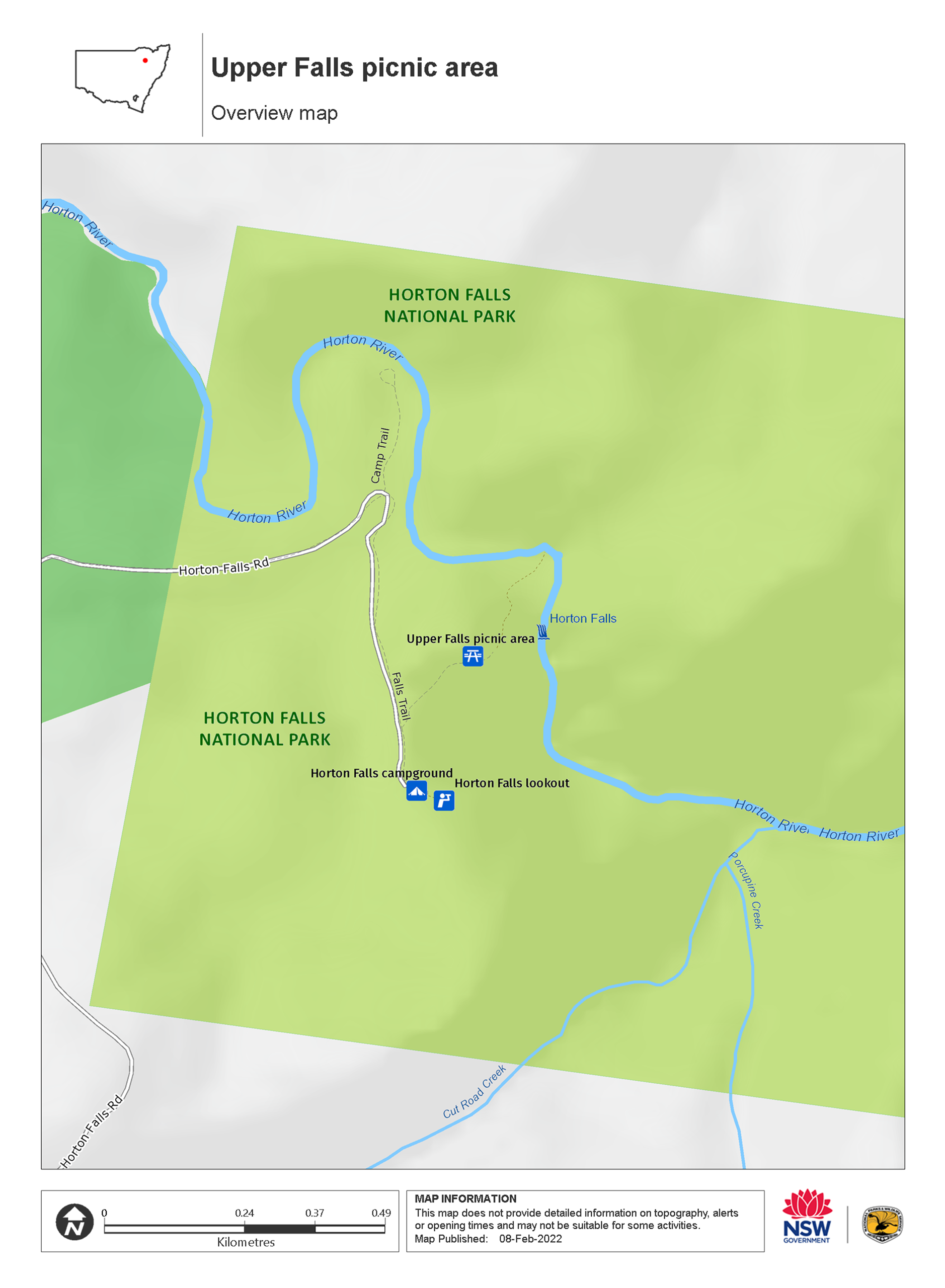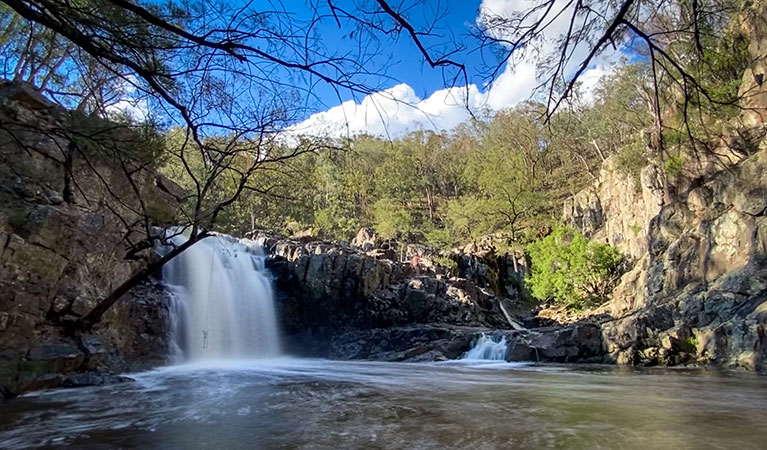Overview
Upper Falls picnic area is in Horton Falls National Park near Horton Falls campground and picnic area. It’s a great spot to stop for a snack when you visit the park’s waterfalls, walks and lookouts.
Upper Falls picnic area has a barbeque, table and toilet facilities for day visitors to Horton Falls National Park. The picnic area is next to the start of a scenic walking track to Upper Falls waterfall.
Nearby
-

Horton Falls lookout
Horton Falls lookout is in Horton Falls National Park near Horton Falls campground and picnic area. The lookout is a great vantage point for viewing the waterfall and rock pools.
-

Horton Falls campground and picnic area
Tucked away in the rugged foothills of the Nendewar Range is Horton Falls campground and picnic area. With just 2 campsites, nature lovers can explore the waterfalls, swimming holes and gorges of Horton Falls National Park, near Barraba.
These maps give a basic overview of park attractions and facilities, and may not be detailed enough for some activities. We recommend that you buy a topographic map before you go exploring.
Map

Map legend

Local alerts
For the latest updates on fires, closures and other alerts in this area, see https://www.nationalparks.nsw.gov.au/things-to-do/picnic-areas/upper-falls-picnic-area/local-alerts
General enquiries
- National Parks Contact Centre
- 7am to 7pm daily
- 1300 072 757 (13000 PARKS) for the cost of a local call within Australia excluding mobiles
- parks.info@environment.nsw.gov.au
Park info
- in Horton Falls National Park in the Country NSW region
Horton Falls National Park is always open but may have to close at times due to poor weather or fire danger.
Visitor info
All the practical information you need to know about the Upper Falls picnic area.
Maps and downloads
Learn more
Upper Falls picnic area is in Horton Falls National Park. Here are just some of the reasons why this park is special:
Aboriginal heritage

Horton Falls National Park is on the lands of the Gamilaroi, Kamilaroi, Gamilaraay and Gomeroi language nation. Aboriginal uses for the park are not well known, however it's likely the park provided a variety resources for day-to-day life. The Falls would have also provided a great vantage point looking south east over the gorges.
Landscapes and geology

Horton Falls National Park is located on the eastern foothills of the Nandewar Range, an area formed by volcanic activity which occurred about 17 to 21 million years ago. The landscape of the park is undulating with a deeply incised valley headed by Horton Falls on the Horton River. The Horton River starts below Mount Kaputar and drops 83m at Horton Falls into a deep gorge, eventually merging with the Gwydir River beyond the park boundary.
A natural paradise

The park displays a diverse range of plant communities due to its steep topography and the water courses that divide the park. Wedge-tailed eagles, crimson and eastern rosellas, kookaburras, honeyeaters and occasionally sulphur-crested cockatoos are among the bird species that call this park home. Smaller birds such as wrens, thornbills and tree-creepers can also be found in shrubs and heaths. At night, you might even spot the common brushtail possum or feathertail gliders, or hear the calls of the southern boobook. The park is also home to several threatened species including the flame robin, diamond firetail and corbens long-eared bat.
Plants and animals protected in this park
Animals
-

Yellow-tailed black cockatoo (Calyptorhynchus funereus)
The yellow-tailed black cockatoo is one of the largest species of parrot. With dusty-black plumage, they have a yellow tail and cheek patch. They’re easily spotted while bird watching, as they feed on seeds in native forests and pine plantations.
-

Common brushtail possum (Trichosurus vulpecula)
One of the most widespread of Australian tree-dwelling marsupials, the common brushtail possum is found across most of NSW in woodlands, rainforests and urban areas. With strong claws, a prehensile tail and opposable digits, these native Australian animals are well-adapted for life amongst the trees.
-

Common ringtail possum (Pseudocheirus peregrinus)
Commonly found in forests, woodlands and leafy gardens across eastern NSW, the Australian ringtail possum is a tree-dwelling marsupial. With a powerful tail perfectly adapted to grasp objects, it forages in trees for eucalypt leaves, flowers and fruit.
-

Kookaburra (Dacelo novaeguineae)
Of the 2 species of kookaburra found in Australia, the laughing kookaburra is the best-known and the largest of the native kingfishers. With its distinctive riotous call, the laughing kookaburra is commonly heard in open woodlands and forests throughout NSW national parks, making these ideal spots for bird watching.
-

Regent honeyeater (Anthochaera phrygia)
The regent honeyeater is a critically endangered native bird. Once widespread across south-eastern Australia, only around 250 to 350 birds remain in the wild, making it at risk of extinction.
-

Short-beaked echidna (Tachyglossus aculeatus)
One of only 2 egg-laying mammals in the world, the short-beaked echidna is one of the most widespread of Australian native animals. Covered in spines, or quills, they’re equipped with a keen sense of smell and a tube-like snout which they use to break apart termite mounds in search of ants.
-

Sugar glider (Petaurus breviceps)
The sugar glider is a tree-dwelling Australian native marsupial, found in tall eucalypt forests and woodlands along eastern NSW. The nocturnal sugar glider feeds on insects and birds, and satisfies its sweet tooth with nectar and pollens.
-

Wedge-tailed eagle (Aquila audax)
With a wingspan of up to 2.5m, the wedge-tailed eagle is Australia’s largest bird of prey. These Australian animals are found in woodlands across NSW, and have the ability to soar to heights of over 2km. If you’re bird watching, look out for the distinctive diamond-shaped tail of the eagle.
Plants
-

Grass tree (Xanthorrea spp.)
An iconic part of the Australian landscape, the grass tree is widespread across eastern NSW. These Australian native plants have a thick fire-blackened trunk and long spiked leaves. They are found in heath and open forests across eastern NSW. The grass tree grows 1-5m in height and produces striking white-flowered spikes which grow up to 1m long.
-

Wonga wonga vine (Pandorea pandorana)
The wonga wonga vine is a widespread vigorous climber usually found along eastern Australia. A variation of the plant occurs in the central desert, where it resembles a sprawling shrub. One of the more common Australian native plants, the wonga wonga vine produces bell-shaped white or yellow flowers in the spring, followed by a large oblong-shaped seed pod.
-

Mulga (Acacia aneura)
Mulga are hardy Australian native plants found throughout inland Australia. With an unusually long tap root, the mulga is able to withstand long periods of drought.

